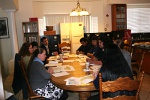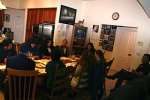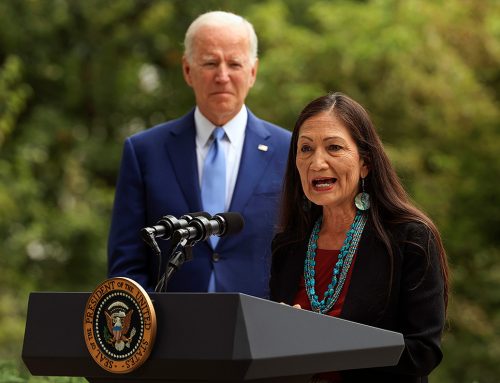The California Valley Miwok Tribe (located at 10601 N. Escondido PL, Stockton, CA, as listed in the Federal Register of the Bureau of Indian Affairs, BIA/DOI), a federally recognized tribe eligible to receive and distribute contracted services from the federal government – on Friday, April 8, 2011, held a meeting at the tribal offices with officials from the United States Army Corps of Engineers (USACE); which also included members from the Calaveras Band of Me-Wuk Indians and the Calaveras County Mountain Mi-Wuks (member tribes of the Tri-Miwok Consortium). The purpose of the meeting was to discuss various concerns in a variety of projects currently being conducted within the geographic aboriginal areas of the member tribes.
An agenda was provided to all whom attended the meeting and after introductions, Mark Gilfillan, Tribal Liaison/Project Manager of the Regulatory Division (Office of the Chief, Grand Junction, Colorado), of USACE, handed out multiple folders of information and discussed in-depth various issues that would involve Army Corps oversight; including but not limited to: dams, levees, river channels, harbors and trust responsibility – as well as cultural resources and management and of consultation with tribal nations. Mr. Gilfillan also went into further detail concerning the sharing of information to strengthen the already many years’ long relationship between the California Valley Miwok Tribe and USACE. Paul Maniccia, (Chief, California South Branch Regulatory Division, Sacramento District, USACE), then took the discussion into the current projects and of the protection of the waterways that exist within some of the projects being discussed, providing previous background information and handing out items symbolizing the meeting that was taking place on this day.
The meeting was taken into deeper detail by the California Valley Miwok Tribe’s Cultural Preservation Director, Ms. Debra Grimes, regarding the previous experiences of her and her department’s staff within projects being discussed; of concern over structures, sites, pathways, and waterways that have not been to this date properly addressed. She also talked about the need to have more adequate testing procedures, of the various acts outside of compliance, of the need for the proper following of federally mandated guidelines and for more thorough testing to assure the minimization of cultural impact on one of the specific projects discussed on this day. On all projects, she expressed the need for a better relationship between the native peoples and project individuals, to be able to work more closely to address cultural concerns and help to alleviate unforeseen costs that could eventually arise in the future of many of these projects. She also spoke of some projects changing hands repeatedly, causing confusion between the new owners and cultural departments over information already documented and of the concern that unless protected, a site is gone forever once it is allowed to be decimated. Immediate and various future impacts were discussed between the Tribe and USACE representatives Erin Hess (Cultural Resource Specialist, USACE, Sacramento District), Kathy Norton (Ecologist/Project Manager, USACE, Sacramento District), Mark Gilfillan (Tribal Liaison/Project Manager) and Paul Maniccia (Chief of the California South Branch, USACE).
This discussion went on for some time and addressed all possible concerns by the tribes and USACE and all parties talked of the many ways to better coordinate and implement actions which would alleviate most of these concerns, enabling a future cohesiveness between all whom attended this meeting, to better address any issues that may arise in the future to the benefit of all, including initiators of any future projects within these tribes’ sphere of influence. There was a break during which refreshments were provided and a tour was given to the USACE personnel of the tribal offices and the walls displaying the many years of the Tribe’s achievements and relationship with the federal government; including the many correspondences from their Commander-in-Chief, President of the United States, Barack Obama. The day ended with a re-cap of all that was discussed, which amongst other issues included: wetlands, monitoring, biological issues, endangered species and indigenous plants; the USACE’s interaction with other agencies and of taking this working relationship yet a step further, implementing all that was shared on this day for the benefit of all.
At this time, the California Valley Miwok Tribe would like to thank all representatives of the USACE whom gave of their time to attend this previously scheduled meeting and to Tri-Miwok Consortium member tribes, the Calaveras Band of Me-Wuk Indians and the Calaveras County Mountain Mi-Wuks, for their participation.









